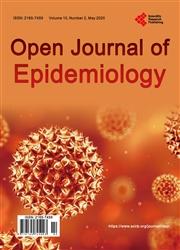First Hour Initiation of Breast Feeding & Associated Factors, among Mothers at Post Natal Ward in Fort Portal Referral Hospital, Uganda
引用次数: 2
Abstract
Background: Breast milk is recommended as the best feeding option to neonates and infants for it confers immunological benefits that help to reduce neonatal and infant morbidities and mortalities. WHO recommends that all infants should start breast feeding within one hour of birth i.e. early initiation of breast feeding (EIBF). Unfortunately, studies show that less than 40% of infants in resource limited settings Uganda inclusive are initiated on breast feeding practice, with no documented study done in Kabarole district to assess the problem. This study therefore, set out to establish the prevalence and associated factors with the practice of first hour initiation of breast feeding at Fort Portal Regional Hospital, Kabarole district, Uganda. Methods: With a cross-sectional design, we collected data from 330 post natal mothers and their live-born infants at Fort Portal Regional Referral hospital from 5th-20th August 2019. With a standard interviewer administered tool, mothers who initiated breast feeding within the first hour after delivery of their newly born babies responded with yes and those that did not with a no. Prevalence of one hour initiation was got considering infants that were initiated on breast within one hour over the total live birth times 100 to get the percent prevalence. With Stata version 13 software, statistically significant relationships of the predisposing factors were determined at a p-value (p ≤ 0.05) at bivariate and at multivariate regression coefficient. Results: A total of 330 postnatal mothers targeted for this study, 100% response rate was covered. Mothers’ age ranged from 18 - 45 years with mean age 31 SD ± 6. The prevalence of initiation of breast feeding in the first hour of birth was 68%, a third of (32%) mothers had not initiated breast feeding in the first hour. A half (50%) of the direct predisposing factors for non-initiation of timely breastfeeding were due to birth asphyxia, almost a quarter 23% due to mother’s ill health and 7% due mother not being guided by the health worker on what to do. In this study mothers’ knowledge and awareness of the practice were very low at 20% while that of health workers was fair at 53%. Social demographic factors that influence 1st hour breast feeding practice were; young maternal age being less than 34 years, mothers occupation being self-employed (83%) or unemployed (73%) with 3 times higher odds of initiating breastfeeding within 1st (OR = 3, p = 0.003) than working class mothers (civil servants). Marital status of mothers being married (73%) significantly influenced early breastfeeding practice (p = 0.001). Health workers’ knowledge of the practice was significantly associated (OR = 2.7, X2 = 11.32, *p = 0.00078) with enforcement of mother initiation of breast feeding in first hour compared to the less knowledgeable ones. Conclusion: The practice of timely initiation of breastfeeding at Fort Portal Regional Referral hospital at 68.2% was sub-optimal against WHO universal practice recommendations. Mothers’ low knowledge on timely initiation of breast feeding practice was the most deterrent factor for first hour initiation of breastfeeding practice. Providing breastfeeding counselling to all mothers during ANC and training on best breastfeeding practices and counselling skills for health staff at Fort Portal Referral hospital are urgent recommendation in this study to improve the practice.乌干达门户堡转诊医院产后病房母亲的第一个小时开始母乳喂养及相关因素
背景:母乳被推荐为新生儿和婴儿的最佳喂养选择,因为它具有免疫益处,有助于降低新生儿和婴儿的发病率和死亡率。世卫组织建议所有婴儿应在出生后一小时内开始母乳喂养,即早期开始母乳喂养。不幸的是,研究表明,在包括乌干达在内的资源有限的环境中,只有不到40%的婴儿开始了母乳喂养实践,而且没有在Kabarole地区进行有记录的研究来评估这一问题。因此,本研究旨在确定乌干达卡巴罗尔地区波尔特堡地区医院第一个小时开始母乳喂养的流行情况及其相关因素。方法:采用横断面设计,收集2019年8月5日至20日在波特尔堡地区转诊医院就诊的330名产后母亲及其活产婴儿的数据。使用标准的采访者管理工具,在新生儿出生后第一个小时内开始母乳喂养的母亲回答“是”,而那些没有开始母乳喂养的母亲回答“否”。一小时内开始母乳喂养的婴儿占总活产婴儿的一小时内开始母乳喂养的婴儿的比例乘以100,得到一小时内开始母乳喂养的婴儿的比例。采用Stata version 13软件,在双变量和多变量回归系数的p值(p≤0.05)下确定易感因素之间的关系有统计学意义。结果:本研究共纳入330名产后母亲,有效率100%。母亲年龄18 ~ 45岁,平均年龄31 SD±6。在出生后一小时开始母乳喂养的发生率为68%,三分之一(32%)的母亲没有在出生后一小时开始母乳喂养。未及时开始母乳喂养的直接易感因素有一半(50%)是由于出生窒息,近四分之一(23%)是由于母亲健康状况不佳,7%是由于母亲没有得到卫生工作者的指导。在这项研究中,母亲对这种做法的了解和意识非常低,为20%,而卫生工作者的了解和意识相当低,为53%。影响第1小时母乳喂养的社会人口因素有:年轻母亲年龄小于34岁,母亲职业为自营职业者(83%)或无业(73%),1年内开始母乳喂养的几率是工人阶级母亲(公务员)的3倍(or = 3, p = 0.003)。已婚母亲的婚姻状况(73%)显著影响早期母乳喂养做法(p = 0.001)。卫生工作者对该做法的了解程度与母亲在第1小时开始母乳喂养的执行程度显著相关(OR = 2.7, X2 = 11.32, *p = 0.00078)。结论:与世卫组织普遍做法建议相比,波尔特堡地区转诊医院及时开始母乳喂养的比例为68.2%,属于次优做法。母亲对及时开始母乳喂养实践的知识不高是开始母乳喂养实践第一个小时的最大阻碍因素。本研究的紧急建议是,在非国大期间向所有母亲提供母乳喂养咨询,并对门户堡转诊医院的保健工作人员进行最佳母乳喂养做法和咨询技能培训,以改进这一做法。
本文章由计算机程序翻译,如有差异,请以英文原文为准。
求助全文
约1分钟内获得全文
求助全文

 求助内容:
求助内容: 应助结果提醒方式:
应助结果提醒方式:


